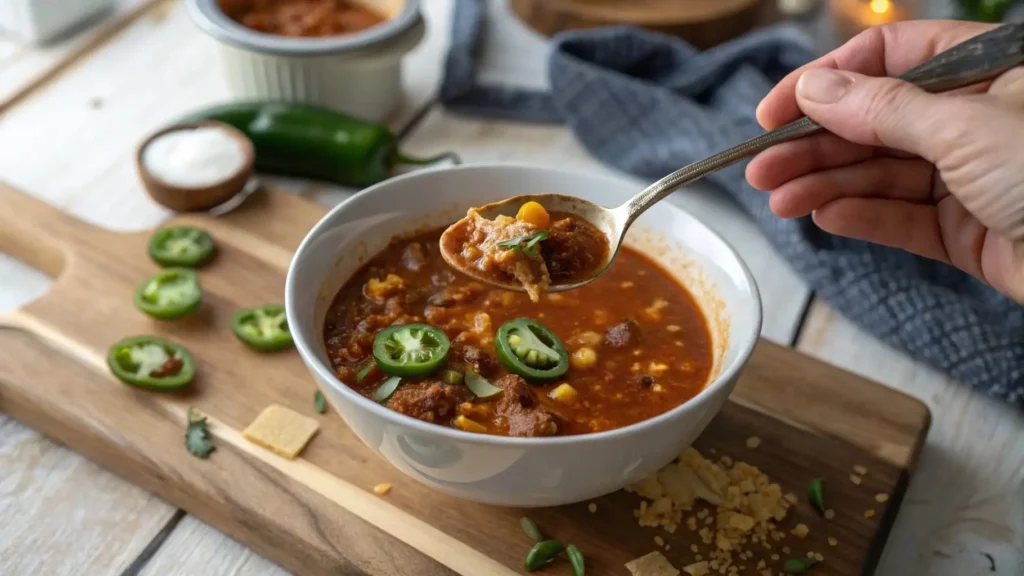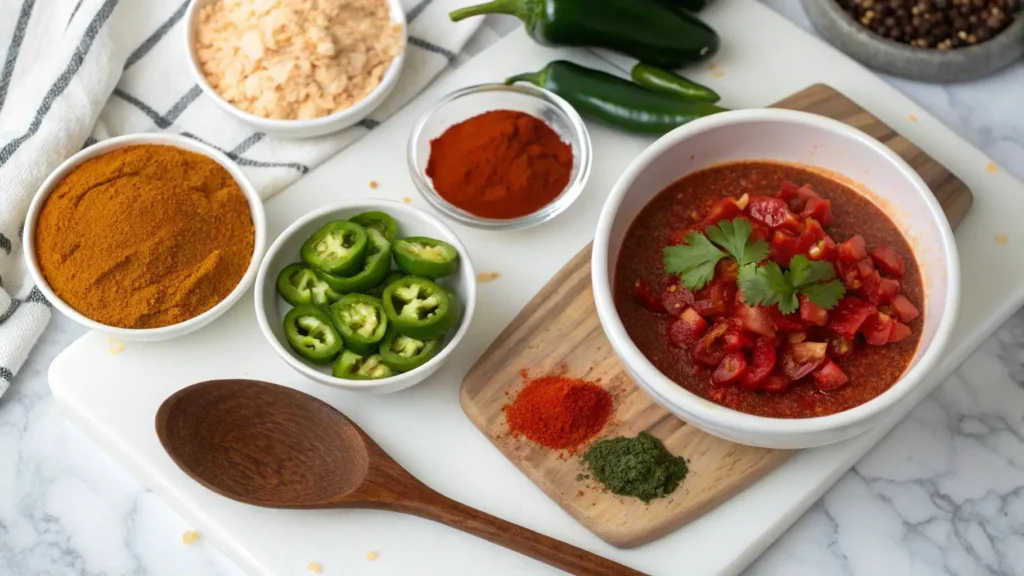Introduction: How to fix taco soup that is too spicy?
Taco soup is one of those cozy, flavorful meals you look forward to on chilly evenings. But, you know, sometimes you can get a little too enthusiastic with the spice. Maybe you went a bit heavy on the jalapeños or the chili powder, and now your taco soup is burning your taste buds instead of warming your soul. Don’t worry, though—there’s no need to start over. I’ve got a few tricks up my sleeve to help you fix that fiery bowl of soup and make it delicious again. Let’s dive in! How to fix taco soup that is too spicy?
Table of Contents
Understanding the Problem: Why is Taco Soup Too Spicy?

Spice can be a tricky thing. Some people love a mouth-on-fire experience, but if you’re not one of them, a too-spicy taco soup can quickly go from comforting to uncomfortable. It could be that you added extra hot peppers, or maybe the seasoning mix you used was just a little too powerful. Whatever the reason, that heat needs to be tamed—stat.
The good news? There are several simple ways to bring the spice down to a more manageable level. Let’s look at the ingredients and how they affect the overall heat of your soup.
Common Ingredients That Add Heat to Taco Soup

If you’ve ever cooked taco soup, you know that a few key ingredients are responsible for adding that spicy kick. Here’s a rundown of the usual suspects:
- Jalapeños: These little green peppers can vary in heat, but they’re often the main culprit when taco soup gets too spicy.
- Chili Powder: It’s a staple in taco seasoning, but if you go overboard, it can make your soup way hotter than expected.
- Cayenne Pepper: A little pinch can go a long way, and it’s often added to boost the heat.
- Hot Sauce: A dash here and there can add some flavor, but too much can leave you reaching for a glass of milk.
So, what can you do when your taco soup is all about that heat but not in the way you want?
How to Determine the Spice Level in Your Taco Soup
Before jumping into solutions, it’s good to understand how spicy your soup really is. Take a small spoonful and give it a taste. Does it hit you right away with that burning sensation, or does it build slowly? If it’s a quick, intense burn, your soup probably has an overload of hot ingredients like jalapeños or cayenne. If the spice is milder and lingers, it could be the chili powder mix you used.
Now, let’s talk about how you can fix it!
Quick Fixes: Simple Solutions to Reduce Spice
The great thing about taco soup is that it’s easy to adjust, even when it’s too spicy. Here are some quick fixes that’ll take your soup from “whoa!” to “yum!” in no time.
Adding Dairy: The Power of Creaminess
Dairy is your best friend when it comes to calming down heat. If your taco soup is on fire, adding something creamy can really help mellow out the spice. A dollop of sour cream, a splash of heavy cream, or even some cream cheese can cut the heat and add a rich, velvety texture to your soup. Plus, the tanginess of sour cream pairs perfectly with the flavors of taco soup!
Pro tip: If you’re looking for a quick fix, try stirring in some sour cream directly into your bowl before you dive in. You’ll be amazed at how much it helps.
Adding Sweetness: Honey, Sugar, or Maple Syrup
When heat gets too intense, sweetness can be your secret weapon. A small amount of honey, sugar, or even maple syrup can balance out the spice without turning your soup into a dessert. You don’t need much—just a teaspoon or two, and taste as you go. It’s a sweet way to take the edge off without compromising on flavor.
Trust me, I was skeptical the first time I tried adding a touch of honey to my chili—it sounds weird, but it really works!
Diluting with Broth or Water
If the soup is still too hot for your liking, you can dilute the spiciness by adding more liquid. Pour in some extra broth or even water to thin it out. The broth will keep the flavor, while the water will just reduce the concentration of heat. Either way, you’re toning down the spice without losing all the yummy flavor you’ve worked so hard to build.
This trick is super handy if you’ve made a big batch of taco soup and find it’s too spicy to handle. Just add liquid, simmer, and taste as you go.
Adding Vegetables: A Fresh Approach to Balance Heat
Vegetables can absorb some of that heat and add bulk to your soup, making it feel more balanced. Plus, they add great texture and flavor. Think about adding things like diced tomatoes, corn, or bell peppers. They won’t just make the soup milder—they’ll make it even more satisfying!
So, what vegetables work best?
Which Vegetables Work Best for Taco Soup?
- Corn: Sweet corn is a fantastic option. It adds a nice pop of sweetness and texture that helps balance out the heat.
- Bell Peppers: These are a great choice because they’re mild in flavor but add a nice crunch.
- Tomatoes: Diced tomatoes can absorb some of the heat, especially if you use fresh ones or add a bit of tomato paste for depth.
Feel free to get creative here—if you’ve got veggies hanging out in the fridge, they can probably join the taco soup party!
Bottom Line
If your taco soup turns out too spicy, don’t panic. There are plenty of easy ways to dial down the heat and still keep all that delicious taco goodness intact. Whether it’s adding dairy, sweetness, broth, or veggies, you’ve got options that’ll save the day. And honestly, with a little tweaking, your taco soup can go from “burn-your-mouth” to “comfort-food-perfect” in no time.
Advanced Fixes: More Creative Ways to Tame the Spice
Sometimes, the simple fixes just don’t do the trick, right? If your taco soup is still packing more heat than you can handle, it might be time to get a little more creative. Don’t worry—there are plenty of ways to bring the spice under control, even when things have gotten out of hand. Let’s look at some advanced techniques to rescue your soup from the spice overload.
Using Acidic Ingredients: Lime or Lemon Juice
One of the best-kept secrets to balancing heat in spicy dishes is acidity. A squeeze of lime or lemon juice can instantly tone down the burn and add a refreshing twist to your taco soup. The acidity helps neutralize the spicy compounds, making the heat feel much more manageable.
If you’re wondering how much to use, start with a small squeeze (about half a lime or lemon) and stir it in. Then, give it a taste and adjust as needed. This little trick won’t just calm the heat; it’ll also give your soup a bright, zesty flavor that pairs perfectly with all the savory ingredients in your taco soup.
Incorporating Starches: Rice, Potatoes, or Tortilla Chips
Starches are another great way to absorb some of that heat. Adding rice, potatoes, or even tortilla chips can help soak up some of the spice while adding heartiness to your soup.
- Rice: Adding a scoop of rice is an easy fix. It absorbs liquid (and some of that heat), making each bite less spicy while filling you up.
- Potatoes: Diced potatoes can soak up a lot of heat, especially when added toward the end of cooking. They’ll also add a creamy texture as they soften.
- Tortilla Chips: Crushed tortilla chips are a fun addition to your soup. They’ll absorb some of the spice and add a crispy, salty crunch—perfect for texture and flavor.
These ingredients are perfect for when you want to stretch your soup a little further and make it more filling while taming the spice. Trust me, I’ve been there and I can vouch for how well this works!
Preventing Spicy Taco Soup in the Future
Alright, you’ve fixed your too-spicy taco soup this time, but how do you make sure this doesn’t happen again? Let’s talk prevention. It’s all about keeping a closer eye on your spice levels during cooking and choosing ingredients that give you more control over the heat. After all, no one wants to go through this spicy soup saga every time, right?
Adjusting Spice Levels During Cooking
The key to keeping your taco soup at the perfect spice level is adjusting as you go. Always taste your soup as it cooks, especially after adding any spices or hot ingredients like peppers. If you’re using a pre-made seasoning mix, start with less than what the recipe calls for and add more if needed. It’s way easier to add spice than to take it out, so go slow and taste as you go.
Another tip? Keep the spicy ingredients like chili powder, cayenne, and hot sauce on the side until the end. This way, you can add a little at a time and avoid overdoing it. Plus, this gives everyone the option to spice things up to their own taste when serving, which is always a win!
Choosing the Right Ingredients for Controlled Heat
If you’re making taco soup from scratch, choosing the right ingredients can make all the difference. Instead of using extra-hot peppers like jalapeños or habaneros, you can opt for milder varieties, such as poblano peppers or even bell peppers. These add flavor without the intense heat.
Also, consider using chili powder that has a balanced flavor profile. Some chili powders are way hotter than others, so try to find one that’s a good fit for your taste. If you’re using store-bought taco seasoning, you might want to check the spice level—some brands pack a punch, while others are much milder.
By picking your ingredients wisely and controlling the heat levels throughout the cooking process, you can make sure your taco soup is always just the right amount of spicy without going overboard.
Final Thoughts
There you have it! If your taco soup ends up too spicy, don’t panic—there are plenty of ways to dial down the heat and save your meal. Whether it’s adding dairy, balancing with sweetness, or getting creative with starches, you can find a solution that works. And for next time? Just remember to taste as you go, adjust those spice levels, and choose ingredients that give you more control over the heat. With these tips, your taco soup will be the perfect balance of flavor and spice every time!
FAQs: Common Questions About Fixing Spicy Taco Soup
I know you’ve got questions, and I’m here to answer them! Let’s take a quick look at some common concerns people have when it comes to spicy taco soup. Whether you’ve already made the soup or you’re just thinking about making it, these tips will help you out.
What to Do if Taco Soup Is Too Spicy After Serving?
If you’ve already served your taco soup and realized it’s too spicy for your guests or even for you, don’t worry. You can still fix it! The quickest way is to add something creamy, like sour cream or heavy cream, directly into each bowl. This will help calm the heat and make the soup more enjoyable.
If you’re serving a large batch, consider adding a little more broth or water to the pot and stirring in some dairy to mellow out the heat. A sprinkle of sugar or a squeeze of lime can also help balance things out. Just taste as you go to make sure the spice is under control.
Can I Use a Spicy Taco Soup Recipe as a Base for Other Dishes?
Absolutely! A spicy taco soup recipe can be the perfect starting point for other dishes. For instance, you could use it as a base for chili by adding more beans or ground beef. You could also turn it into a hearty dip by blending it with some cream cheese or cheddar cheese. It makes a great filling for burritos or tacos, too. The possibilities are endless—just keep the spice level in mind and adjust as needed!
How Can I Make Taco Soup Spicy Without Overdoing It?
If you want your taco soup to have a nice kick but don’t want to overdo it, start slow. Add a little chili powder, cayenne, or a few slices of jalapeño, and taste as you go. You can always add more heat, but once it’s too spicy, you’ll have a tough time toning it down.
Try using mild peppers like poblanos for flavor without as much heat, or stick to one spicy ingredient at a time, like chili powder or hot sauce, and adjust the quantity. It’s all about balance, so take your time and test the heat along the way.
What is Birria Taco Soup Made Of?
Birria taco soup is a rich, flavorful soup inspired by birria, a traditional Mexican stew. It’s typically made with tender beef (or sometimes goat), slow-cooked in a deliciously spiced broth made from dried chiles, garlic, onions, and various spices. The soup often includes tomatoes, cilantro, and lime for added freshness. It’s the perfect mix of spicy, savory, and comforting, and often served with warm tortillas or as a dip for crispy tacos. It’s a hearty, satisfying meal with loads of depth and flavor!
What Can I Use to Thicken Taco Soup?
If your taco soup is a bit too thin, there are several ways you can thicken it up without sacrificing flavor. You can add a can of refried beans, which not only thickens the soup but also gives it a creamy texture. Another option is to stir in some masa harina (corn flour) or a small amount of cornstarch mixed with water to thicken the broth. If you’re looking for a more natural thickener, you could puree a portion of the soup with an immersion blender, blending in some of the vegetables and beans to create a thicker consistency.
How Long Will Taco Soup Last in the Freezer?
Taco soup freezes surprisingly well! If you have leftovers (or made a big batch on purpose), you can store it in an airtight container or freezer bag for up to 3 months. When you’re ready to enjoy it again, just defrost in the fridge overnight and heat it up on the stove. Keep in mind that if your soup has dairy in it, the texture might change a bit after freezing, so you may want to add a little extra liquid when reheating to get it back to that perfect consistency.
Conclusion: Enjoy Your Perfectly Spiced Taco Soup
Making the perfect taco soup is all about balancing flavors and finding the right level of spice. Whether you’re trying to fix a soup that’s too spicy or aiming to make the ideal bowl from the start, you’ve got plenty of options to choose from.
Quick Recap of Fixes for Spicy Taco Soup
- Add dairy (like sour cream or heavy cream) to calm the heat.
- Sweeten with a little honey or sugar to balance the spice.
- Dilute with more broth or water if it’s way too hot.
- Add vegetables like corn, bell peppers, or potatoes to absorb some of the heat.
- For a creative fix, try adding lime or lemon juice for acidity, or rice and tortilla chips for starch.
Next time you’re making taco soup, just remember to taste as you go and keep those spice levels in check! Whether it’s your first time cooking or you’re a seasoned pro, you now know how to adjust and enjoy your soup just the way you like it. Happy cooking!

